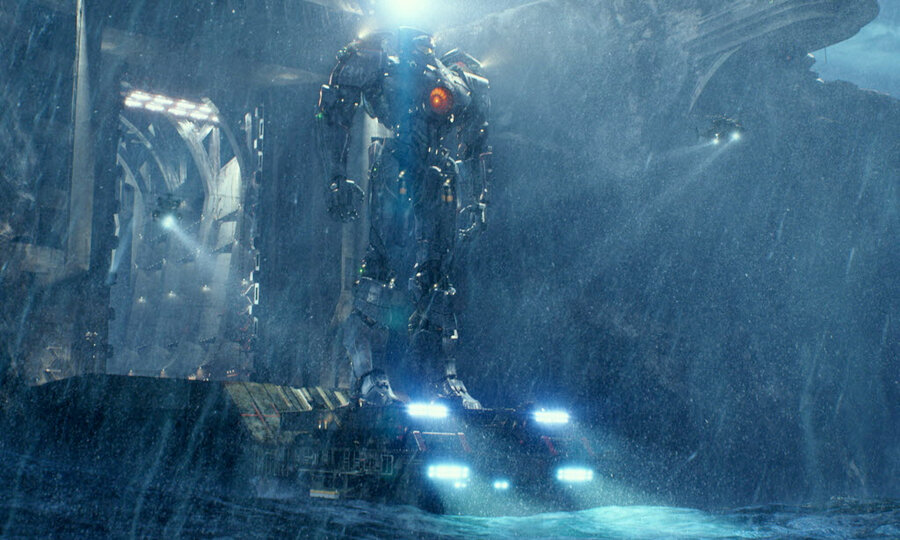'Pacific Rim' director Guillermo Del Toro discusses his favorite monster movies
Loading...
| NEW YORK
The appeal of "Pacific Rim" isn't complicated.
Like the kind of boyhood fantasy that delights in flying men and relishes dreams of dinosaurs, "Pacific Rim," the latest film from director Guillermo Del Toro, is predicated on the simple, childlike thrill of seeing big ol' robots and big ol' monsters slug it out.
But while summer spectacles have grown ever larger in recent years, the monster movie – the original city-smashing genre – has mostly ceded the multiplexes to superheroes and more apocalyptic disaster films. But 14 years after Roland Emmerich's forgettable "Godzilla" remake, Del Toro's "Pacific Rim" constitutes a large-scale attempt to bring Japan's beloved Kaiju movies – their monster films, of which Ishiro Honda's 1954 "Godzilla" is the most famous – to American shores.
"Monsters have always spoken to a part of me that is really, really essential," Del Toro, the Mexican director of the Oscar-nominated "Pan's Labyrinth," said in a recent interview. "All of my life, I felt out of place. The tragedy of every monster in every movie is that they are out of place. That's the essential plight of monsters."
In the 3-D "Pacific Rim," which Warner Bros. will release on July 12, the 25-story-high Kaiju emanate (as is tradition) from the sea one by one, each uniquely grotesque beasts. To combat these monsters and defend the coastlines of the Pacific, equally giant robots called Jaegers are built, each controlled by two brain-connected pilots.
Since he was a child, Del Toro has compulsively drawn monsters, beginning with sketches of the Creature from "Creature from the Black Lagoon" and the Phantom from "Phantom of the Opera." He's still an obsessive drawer (he has a book of drawings for every movie he makes), but creating the creatures and robots of "Pacific Rim" meant working in an entirely different scale.
While the Kaiju films of Toho studios were a formative influence on Del Toro, he boxed up his DVDs before starting work on "Pacific Rim," intent on making a movie that wasn't a mere homage. Instead, he took inspiration less from Japanese monster films than paintings like Goya's "The Colossus" (which depicts a passing muscular giant, with fists raised, surrounded by clouds) and George Bellows' visceral boxing paintings of hulking combatants.
"I wanted to bring the awe and spectacle of when you watch something so big that the scale is inhuman," says Del Toro. "I kept thinking of the Goya painting because it seemed detached from ethical judgment. It's so beyond human. It's like watching a tornado and a hurricane clash."
Del Toro speaks majestically about monsters and robots, which might sound comical if he wasn't so earnestly heartfelt. With "Pacific Rim," he sought the operatic grandeur of Goya and Bellows, attempting to capture what he calls "a beautiful monster pageantry." Battles would take place in the middle of the sea, with swirling storms and torrents of water.
"Guillermo's approach is to just show his passion," says visual effects supervisor John Knoll, the chief creative officer of Industrial Light and Magic. "When everyone on the crew sees how much Guillermo loves this stuff, how much it means to him, the enthusiasm is contagious."
Del Toro, also a producer and co-screenwriter, worked closely with the effects team at ILM to create the battle sequences between the giant robots and creatures that make up much of the film. It was a particularly challenging project because of the scale involved, in addition to the frequent presence of water – long a computer graphics headache.
"We sort of know how to make things look really big: You slow them down, there are other visual cues you can give it to say this thing is 250 feet tall," says animation director Hal Hickel. "But if everything is moving very slowly, that could potentially be boring. You don't want everything to look like it's in a slow-motion. The trick for us was to move things in a way that suggested their gigantic size and felt kind of realistic-ish, but at the same time was exciting to watch."
The Kaiju film was birthed as a kind of fire-breathing metaphor for nuclear atrocity, with "Godzilla" coming nine years after the atomic bombings of Hiroshima and Nagasaki. In 2011, a new kind of nuclear nightmare occurred with the Fukushima Daiichi meltdown following the devastating earthquake and tsunami.
Work on "Pacific Rim" had already commenced before that disaster, but it's possible a new chapter in the Kaiju film has begun. Legendary Pictures, which produced "Pacific Rim," is also prepping a new "Godzilla" for 2014, to be released by Warner Bros. There's also an adaptation of the 1970s Japanese giant robot animated series "Gaiking" in the works.
Knoll says the Kaiju movie is seeing a resurgence.
"They were great, cheesy fun," says Knoll. "Here was something that was a bit of a love letter to those kinds of films. It was something that really hadn't been done in the West in any significant way. But it's something that's been an enduring part of Japanese culture."
Legendary is hoping that "Pacific Rim" spawns an enduring franchise, an aspiration some have questioned since the $200 million film was reportedly tracking somewhat poorly with preview audiences. Will moviegoers embrace Del Toro's grand Kaiju-robot showdown?
"The only robots we get in America are Transformers," says Del Toro. "What I would love is for a generation of kids to have access to these sort of truly, truly escapist adventure movie. There is not such a thing as reprehensible violence in a Kaiju movie. They are so absolutely anomalous to our reality. You're not going to see an imitation Kaiju attack because a Kaiju saw a movie and decided to attack a mall. It is so guilt free."





